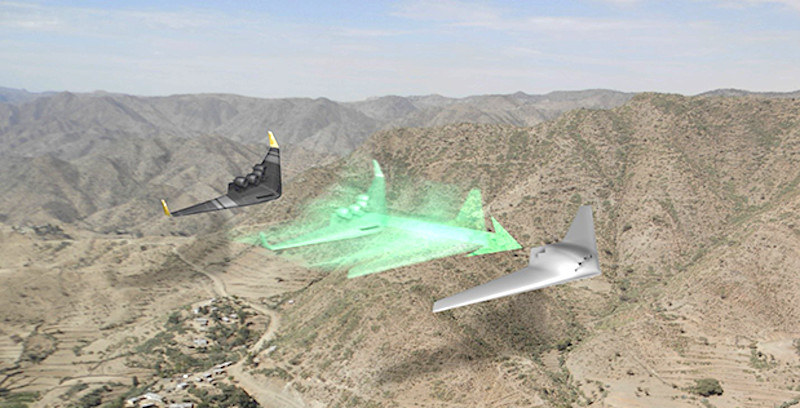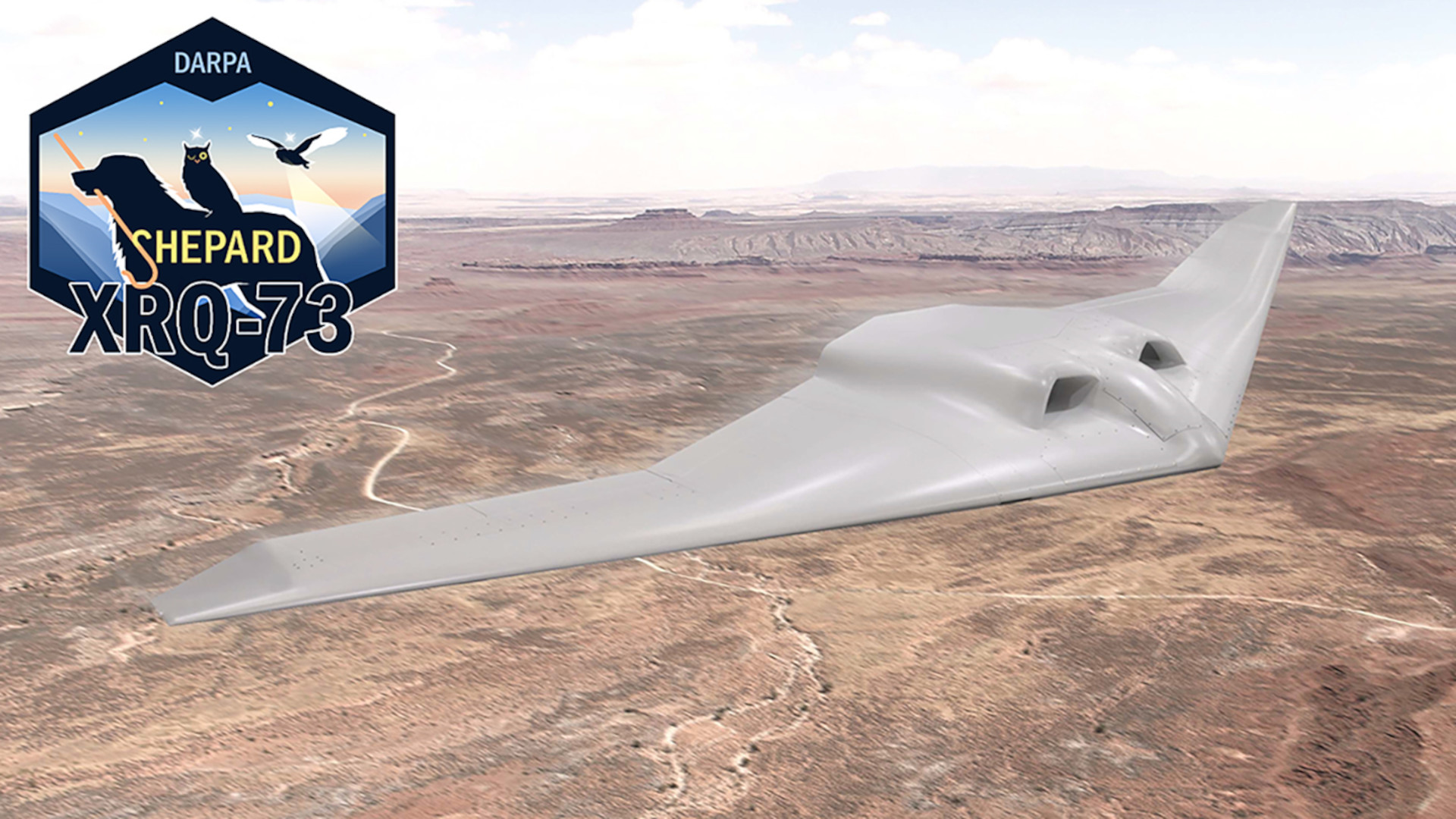A stealthy-looking flying wing drone with a hybrid-electric propulsion system the Defense Advanced Research Projects Agency (DARPA) is developing now has a designation: XRQ-73. DARPA hopes to flight test this uncrewed aircraft later this year and eventually demonstrate it can be operationalized relatively quickly to meet an unspecified “urgent operational need.” The new designation reflects the design’s leveraging of previous work on the secretive ultra-quiet, high-efficiency XRQ-72A drone, which The War Zone was first to report on in detail.
DARPA announced the assignment of the XRQ-73 designation to the drone being developed under what is currently called the Series Hybrid Electric Propulsion AiRcraft Demonstration (SHEPARD) program in a press release earlier today. A new rendering of the design, or what may very well be an actual picture overlaid on top of a computer-generated background, seen at the top of this story, accompanied that release.
DARPA has been running SHEPARD in cooperation with the Air Force Research Laboratory (AFRL) and the Office of Naval Research (ONR) since 2021. Northrop Grumman is the prime contractor for SHEPARD and its subsidiary Scaled Composites is described as a “major supplier.” Cornerstone Research Group, Brayton Energy, PC Krause and Associates, and EaglePicher Technologies are also involved in the project. Scaled Composites developed the XRQ-72 and is well known for producing advanced and novel crewed and uncrewed aircraft designs.

From what can be seen in the current rendering, the XRQ-73 has a tailless flying wing planform. The wing tips notably run on the same plane as the lower airfoil surface, but they are tapered and clipped.

The SHEPARD drone has a general flying wing planform that is similar in some respects to a number of known existing designs, like Lockheed Martin Skunk Work’s RQ-170 Sentinel, P-175 Polecat, and X-44A, as well as Scaled Composites XRQ-72A. A top-secret Northrop Grumman design commonly referred to as the RQ-180 is also speculated to have a general shape that is similar in broad strokes, but be much larger than the XRQ-73 design.

However, unlike many of the existing U.S. flying wing drone designs, the XRQ-73 has a pair of air intakes on top of the central section of the fuselage instead of just one. The SHEPARD uncrewed aircraft’s two intakes flank a fairing in the center. This is a distinctly different configuration from the one seen in the first public rendering DARPA put out for the program, which had four separate intakes.


Beyond it featuring a hybrid-electric propulsion system, details about how the XRQ-73 is powered are limited. Hybrid-electric propulsion systems combine fuel-powered engines and electric motors offering improved fuel economy and other benefits. The addition of batteries further allows for operation in a quieter all-electric mode.
We do know that the preceding XRQ-72A featured two multi-sectioned inlets at the front of its fuselage that fed air, in part, to two fuel-powered generators. Those generators then provided electric power to four ducted fan propulsors mounted on top of the rear of the central fuselage.

No details about the XRQ-73’s expected performance appear to have been released so far, but DARPA says it is a Group 3 uncrewed aerial system (UAS) weighing approximately 1,250 pounds, which will include “operationally representative … mission systems.” By the U.S. military’s definitions, a Group 3 UAS weighs between 55 and 1,320, can fly at altitudes between 3,500 and 18,000 feet, and has a top speed of between 100 and 250 knots.
At 1,250 pounds, the XRQ-73 is set to be substantially larger than the XRQ-72A, the requirements for which called for a drone weighing between 300 and 400 pounds. The XRQ-72A also had a 30-foot wingspan, a length of 11.2 feet measured from the nose to the ends of the wingtips, and a height of four feet when including the vertical wingtip stabilizers, according to schematics The War Zone previously obtained via the FFreedom of Information Act.
DARPA’s release today says that SHEPARD is “leveraging the series hybrid electric architecture and some of the component technologies” from the Great Horned Owl (GHO) program, which produced the XRQ-72A. The U.S. Intelligence Community’s Intelligence Advanced Research Projects Activity (IARPA), in cooperation with AFRL, led the GHO program, which ran from the early 2000s until sometime in the 2010s. You can read more about what is known about the GHO program and the XRQ-72A in The War Zone‘s past feature on that drone.
The SHEPARD program logo has clear references to GHO.

DARPA has not specified what kinds of missions the XRQ-73 might be suited for, but the “RQ” clearly points to an ISR platform. The War Zone previously highlighted how the XRQ-72A’s stealthy and ultra-quiet design looked ideally positioned to conduct covert surveillance in denied areas, and would be even more capable of doing so if the platform could operate persistently at extended ranges. Crafting a drone with a significantly reduced acoustic signature, but without the historic limitations of an all-electric propulsion system was a major focus of the original GHO effort. A hybrid-electric design could also have a notably reduced infrared signature.
Demand within the U.S. military for drones capable of operating in contested or semi-contested environments is growing, in general. Though SHEPARD is now being run through the Department of Defense via DARPA, the U.S. Intelligence Community, especially the Central Intelligence Agency (CIA) with its long history of operating specialized ultra-quiet crewed and uncrewed aircraft, likely still has an interest in the kinds of capabilities the XRQ-73 could offer, as well. The SHEPHARD design could sit below the RQ-170, another program the CIA was also involved in.
“The SHEPARD program is maturing a specific propulsion architecture and power class as an exemplar of potential benefits for the Department of Defense,” Steve Komadina, DARPA’s program manager for SHEPARD, which is also a so-called “X-prime” effort, did say in a statement accompanying today’s release about the XRQ-73. “The idea behind a DARPA X-prime program is to take emerging technologies and burn down system-level integration risks to quickly mature a new missionized long endurance aircraft design that can be fielded quickly.”
DARPA previously said it hoped to be able to get to first flight within 20 months of starting active development on a SHEPARD design by taking advantage of GHO. It’s unclear if the program is still on track to meet that goal.

“Shepard is taking a pure X-plane, the Great Horned Owl, which was a great demonstration of a capability for hybrid-electric propulsion but wasn’t something you can use in the battlespace,” Michael Leahy, then-director of DARPA’s Tactical Technology Office (TTO), also said back in 2021 about SHEPARD, according to Aviation Week. “We’re going to wrap a new skin around it to give it the survivability that it needs. And we’re going to try to demonstrate we can do that quickly.”
Pentagon budget documents also show that SHEPARD was previously a much broader DARPA effort focused on “novel approaches to hybrid-electric propulsion” for use in uncrewed platforms called Air-Ground Autonomous VEhicles (AGAVE). Sometime circa 2021, the goal shifted to specifically integrating that technology “into a unique military aircraft application.” DARPA has received at least $42.77 million for AGAVE and SHEPARD, combined, since Fiscal Year 2020, but curiously does not appear to have requested any money for the latter program since Fiscal Year 2023. It is possible, if not probable that additional funding is (and has been) coming from other streams, including ones in the classified realm.


Whether or not more details about the XRQ-73 and how it me be used operationally emerge, especially around the expected first flight this year, remains to be seen. Details about the preceding XRQ-72 are still scant more than a decade since that program was first publicly disclosed.
Regardless, there is a clear need for a drone like this and its still exotic propulsion system would be a large leap ahead. While maybe not high-profile in nature, the XRQ-73 could end up being an incredibly important aircraft for these two factors alone.
Contact the author: joe@twz.com
